2008 HONDA CRF250 RACE TEST
As with the most popular girl in school, the lucky stiff who wins the lottery jackpot three times, or the couple that decided to vacation in Miami instead of Phuket, the Honda CRF250 has led a blessed life. Not the best-suspended bike, not the fastest bike and not the best-handling bike, the mid-size CRF has been the best selling 250 four-stroke since it was introduced in 2004; outselling the competition by almost two to one. Don’t think that Honda hasn’t tried to spice the CRF250 up with technical innovations. Over the years Honda’s engineers have pioneered their aluminum Delta-Box frame, Unicam rocker arm valve train, twin-sump lubrication system, 40mm Keihin carb and twin exhaust pipes.
And the innovations haven’t stopped for 2008. Although everyone but the MXA wrecking crew expected fuel injection, Honda shelved EFI in favor of HPSD. What does the acronym HPSD stand for? Honda Progressive Steering Damper. Borrowing a page from Team Honda’s playbook, the 2008 CRF’s get the super-secret steering damper that has graced their works bikes since the days of Ricky Carmichael.
The question on the MXA wrecking crew’s mind was whether the 2008 Honda CRF250 was actually improved as a race bike or just bumped up a notch on the hype meter? Our aim was to find out.
Q:WHAT’S SO COOL ABOUT HPSD?
A:Steering dampers aren’t new. They have been around since the 1930s and the Ohlins-built Scotts damper has been available for the motocross market since the mid-’80s. But Honda has taken the idea several steps farther: (1) HPSD is the first production-based motocross steering damper. (2) HPSD offers progressive damping. There is minimal damping force during the first five degrees of angular change off the centerline, but the damping increases exponentially as the handlebars are turned to their furthest point. (3) While damping increases when you turn away from the centerline, it decreases as you return towards it. (4) Although Honda claims 15 clicks of damping adjustment, our CRF250 had 21 clicks.
Q:DOES THE HPSD BENEFIT THE 2008 CRF250?
A:Yes. No surprise. Every time the MXA wrecking crew has tested a Scotts-equipped race bike, the test riders felt that their lap times improved and their work load decreased. Honda discovered the same thing during their test cycles. As an added bonus, Honda’s engineers understood that with the aid of the HPSD system they could decrease fork offset from 24mm to 22mm (something that CRF250 racers have been doing since 2004). The steering damper assists the bike’s stability, while the 22mm clamp increases trail, moves the weight bias forward and improves turn-in. The two changes complement each other. According to Honda, the offset change would never have occurred without the HPSD system.
Q:WHAT WERE OUR BEST HPSD SETTINGS?
A:We ran the HPSD clicker through the wringer, which is how we discovered that it had 21 instead of the claimed 15 settings. In the end, the vast majority of MXA test riders ended up between six and seven clicks out.
Q:DOES THE 2008 CRF250 STILL HAVE TWIN PIPES?
A:Sadly, yes. Maybe it’s just us, but we can’t help but think of Honda’s twin pipes as little more than a marketing gimmick. Honda claims that the twin pipes increase power, decrease sound and balance the chassis in roll mode. We don’t see those benefits in our testing. Our best CRF250 power has come with single-sided aftermarket pipes. The CRF’s sound level is no more or less than the competition at full tilt. And while twin pipes might make a small dent in equalizing the weight between both sides of the machine, they also add more weight to the overall package than a single-sided pipe.
Q:WHAT DID HONDA CHANGE IN THE 2008 CRF250 ENGINE?
A:For 2008, Honda’s focus was in perfect sync with what their customers wanted?more power. To achieve this, Honda’s engineers made three changes: (1) Compression was increased from 12.9:1 to 13.1:1 via a new piston dome. (2) The cylinder head porting and camshaft timing were modified over the 2007 spec and lighter valve train components were implemented. (3) The engine’s counterbalance shaft and gears were reduced in weight to improve throttle response. (4) A new black box and exhaust design bumped the rev limiter up 130 rpm (from 13,370 rpm to 13,500 rpm. (5) The clutch is equipped with stiffer clutch springs and a special judder spring to improve feel.
Q:IS THE 2008 CRF250 FASTER THAN THE 2007 MODEL?
A:Yes, but don’t go all misty on us. It’s faster than the ’07 model, just not night-and-day faster. Honda’s 2008 mods punched up the top-end power, while keeping the the same basic performance characteristics as before (average bottom, good midrange and acceptable top). Longtime CRF250 owners will be impressed with the improvements in the mid-to-top and increased over-rev, but a KX250F owner wouldn’t be.
The biggest test rider complaint about the Honda CRF250’s powerband is the speed at which it revs. The CRF250 takes its time going through its powerband. And while this makes it very easy to ride, it isn’t the quickest way to get from gear to gear or corner to corner. Every MXA test rider wants more snap, a quicker turnover, and a greater sense of urgency out of the 249cc engine.
Q:IS THE DREADED CRF250 CARB BOG GONE?
A:No. To our regret, the CRF250 stills bogs when landing off jumps or whacking the throttle on. Our quick fix was to switch to a leaner needle and richer leak jet.
Q:WHAT DID WE DO TO THE STOCK JETTING?
A:Here are MXA’s 2008 Honda CRF250 jetting specs:
Main Jet: 188
Slow Jet: 42
Needle: NMUU (NMGU stock)
Leak jet: 65 (70 stock)
Clip position: Second from top
Fuel screw: 2-1/2 turns out
Notes: We switched to an R&D Power Pump with an adjustable leak jet. Depending on temperature and elevation, the Power Pump allowed us to richen the leak jet in seconds. Don’t be afraid to go richer on the leak jet (which numerically is a smaller number).
Q:WHAT ABOUT THE GEARING?
A:Since Honda pumped up the mid-to-top for 2008, we could finally use the stock 13/51 gearing. In the past we automatically added one tooth to the rear, but this year we feel that riders should try to live with the stock setup before making any changes.
Q:WHAT DID HONDA DO TO THE SUSPENSION FOR 2008?
A:Historically, MXA test riders have complained about the CRF250 forks being undersprung. For 2008 Honda listened to our complaints and countered with stiffer fork springs (up from 0.44 kg/mm to 0.46 kg/mm).
As for the shock, Honda stiffened the valving to match the stiffer forks.
Q:HOW GOOD IS THE 2008 CRF250 SUSPENSION?
A:We didn’t like the forks. While it’s true that we wished for stiffer fork springs (and Honda obliged our request), in our experience the oil height needs to be lowered to compensate for the spring change. Obviously Honda didn’t make the tit-for-tat trade. The resultant mid-stroke harshness harkens back to the Showa forks of the ’80s. Yikes! Let’s not go there again. Our backyard fix was to drop the fork’s oil height by 28cc, soften the compression, and slow down the rebound.
As for the shock, it was in the ballpark, but the stiffer valving will require riders to work with the high-speed compression more than they are used to. In the end, we turned both compression clickers fairly far out.
Q:WHAT WAS OUR BEST FORK SETTING?
A:For hard-core racing we recommend this fork setup on the 2008 CRF250:
Spring rate: 0.46 kg/mm
Oil height: 380cc (408cc stock)
Compression: 14 clicks out (seven clicks stock)
Rebound: 12 clicks out (nine clicks stock)
Fork leg height: Flush with the top clamp
Notes: We recommend setting the HPSD steering damper at seven clicks out as a starting point. Turning the clicker in slows the damping, while turning it out lightens it. It can be turned out far enough to eliminate any damping effect.
Q:WHAT WAS OUR BEST SHOCK SETTING?
A:For hard-core racing we recommend this shock set-up:
Spring rate: 5.3 kg/mm
Race sag: 102mm
High compression: 2-1/4 turns out (two turns stock)
Low compression: 16 clicks out (14 clicks stock)
Rebound: Six clicks out (eight clicks stock)
Notes: Honda recommends setting the sag between 100mm and 104mm. Lighter riders should opt for the high side of the scale, while heavier riders will want to crank the race sag up.
Q:WHAT DID WE HATE?
A:The hate list:
(1) Forks: These forks are a flashback to an era when the name Showa was synonymous with the phrase “mid-stroke harshness.”
(2) Front tire: The Dunlop D742FA front tire is much improved over the original D742, but that’s not a ringing endorsement. If you want to get the most out the CRF250’s improved handling you need to run a better front tire.
(3) Twin pipes: If twin pipes are such a good idea, why doesn’t the CRF450 come with them?
(4) Grips: There’s no way that a grip should outlast the motorcycle that it’s on. Simply said, Honda’s rubber grips are tougher than Arnold Schwarzenegger in any movie that he’s ever been in (save for his pregnant character in “Junior”).
Q:WHAT DID WE LIKE?
A:The like list:
(1) Triple clamp: The CRF250 has been a decent handler since its inception, just not a great one. The new 22mm offset triple clamps push it higher on the satisfaction scale. Great work!
(2) HPSD: As much as the marketing men like to claim that racing improves the breed, it’s rare that actual “works” parts make it to the showroom floor. HPSD is the exception that proves the rule. This little gem has been hidden behind the front number plates of Ricky Carmichael’s and Kevin Windham’s CRF450 since 2004.
(3) Brakes: The CRF250 front and rear brakes are very precise, and although not the most powerful, they are user friendly.
(4) Options: Honda took the plunge and built a limited number of all-black CRF250’s. Complete with black rims and plastic, the looks says “freestyle” in spades. The black CRF250 costs $200 extra.
(5) Handlebars: The CRF250 is spec’ed with 7/8-inch Renthal 971 handlebars. MXA test riders like 7/8-inch bars…so shoot us.
Q:WHAT DO WE REALLY THINK?
A:You have to appreciate Honda’s efforts on the 2008 CRF250. They laid out a battle plan to improve the handling, innovate fresh technology, stiffen the suspension and perk up the powerband. All great goals. Unfortunately, in the fog of war, not every strategy results in total victory. The other combatants in the 250 four-stroke war won’t have to capitulate to the CRF250 until Honda works out the suspension bugs.


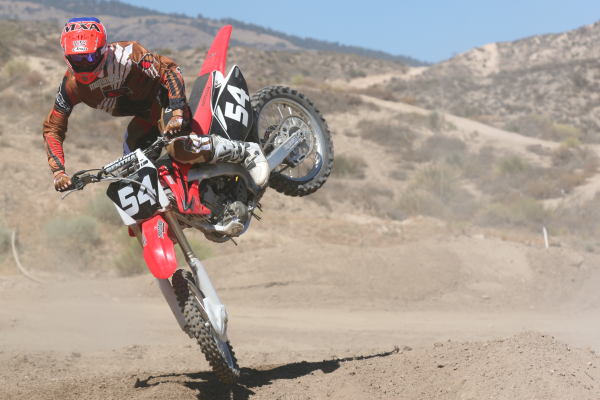
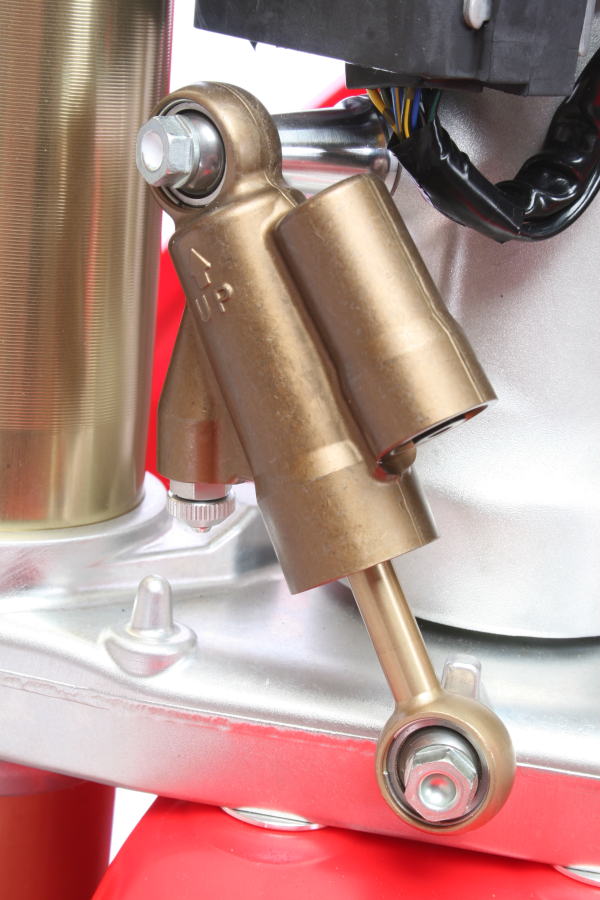
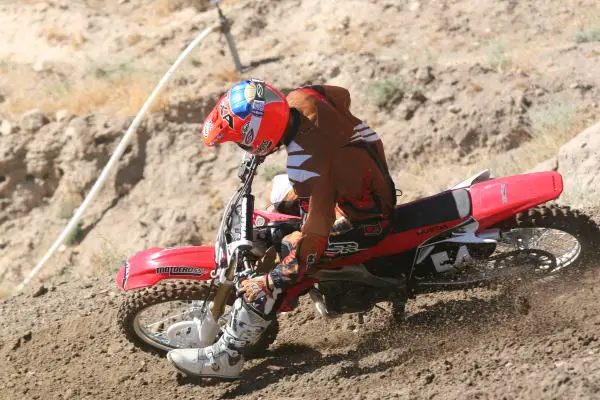
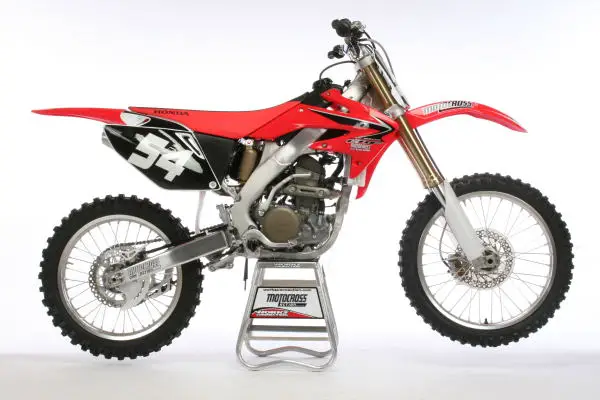

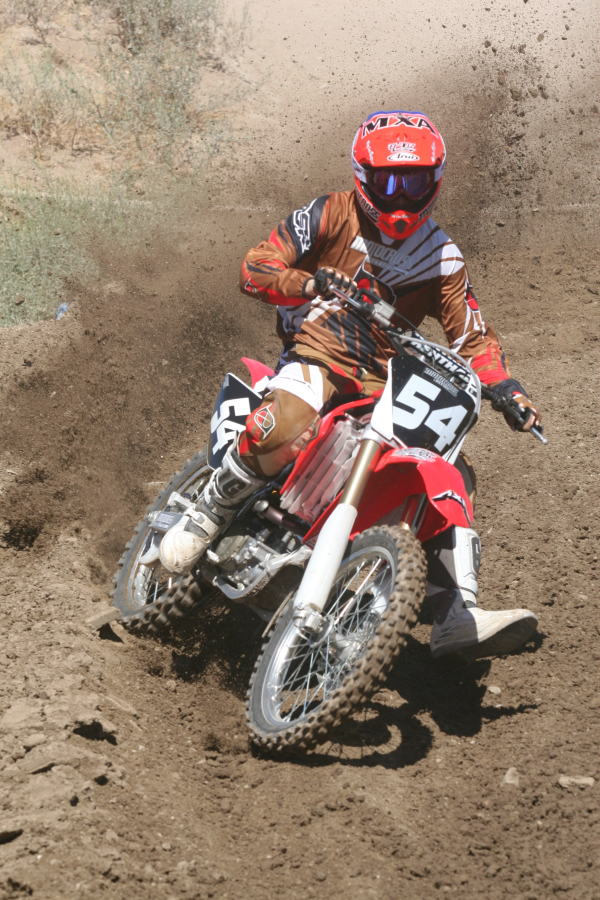


Comments are closed.